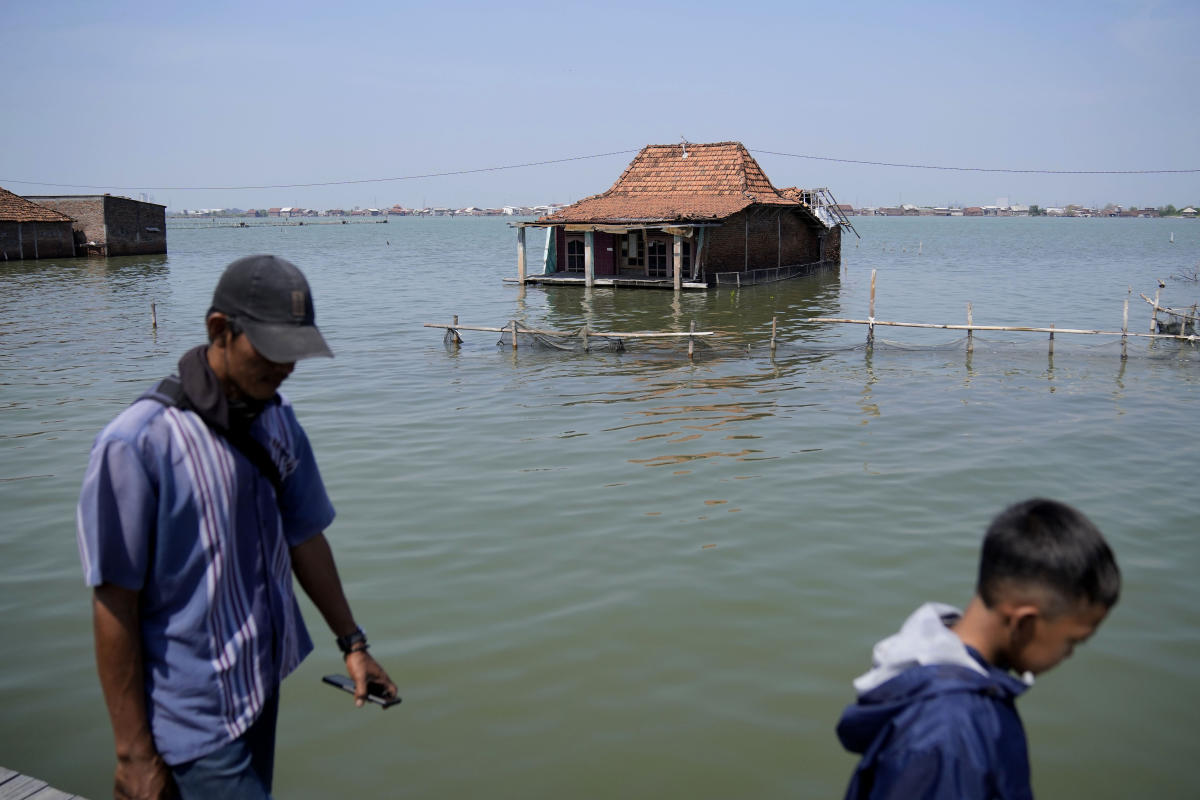
MONDOLIKO, Indonesia (AP) — All the crops had died and the farmed fish had escaped their ponds. The only road to the village was flooded and the water just kept getting higher, says Asiyah, 38, who like many Indonesians uses only one name.
She knew that she had to leave her home on Java’s northern coast, just as many fellow villagers had done months earlier. So about two years ago, after agonizing over the decision for months, she told her husband it was time to go and started to pack.
___
EDITOR’S NOTE: This story is part of an ongoing series exploring the lives of people around the world who have been forced to move because of rising seas, drought, searing temperatures and other things caused or exacerbated by climate change.
___
Java, home to some 145 million people and the Indonesian capital Jakarta, is the most populated island in the world. Scientists say parts of the island will be entirely lost to the sea in the coming years.
Much has been written about the sinking capital, which is being moved partially due to destructive flooding. Other parts of the country with persistent flooding have received less attention.
Some 300 miles (500 kilometers) from Jakarta, entire villages along the Java Sea are submerged in murky brown water. Experts say rising seas and stronger tides as a result of climate change are some of the causes. Gradual sinking of the land and development are also to blame.
Mondoliko, where Asiyah is from, is one of those villages.
Asiyah smiles as she describes what Mondoliko was like when she was young: Lush green rice paddies, tall coconuts trees and red chili bushes grew around the some 200 homes people lived in. She and other children would play in the local soccer field, watching snakes glide through the grass while butterflies flew through the air.
“Everyone had land,” she says. “We were all able to grow and have what we needed.”
But around 10 years ago, the water came — sporadically and a few inches high at first. Within a few years it became a constant presence. Unable to grow in salt water, the crops and plants all died. With no land left as the water got higher, the insects and animals disappeared.
Asiyah says she and other villagers adapted the best they could: Farmers swapped their crops for fish ponds; people used dirt or concrete to raise the floors of their homes above the water. Net fences were put in yards to catch the trash the tide would bring in.
For seven years Asiyah, her husband Aslori, 42, and their two children lived with the floods, the water getting higher every year. But they noticed changes as well: Neighbors were leaving their homes behind in search of drier land. The call to prayer at the village mosque went quiet. Even new fish ponds became futile, the water rising so high that the fish would jump over the nets.
She remembers the day she decided they had to leave her lifelong home. Her father, who lived with them, had been battling bone cancer and prostate issues, and some days he was so frail he couldn’t stand. Her son was getting bigger and faced an increasingly difficult, waterlogged commute to school over 2 miles (about 3 kilometers) away.
“I was worried when the road flooded — how can we go about our daily lives?” she remembers wondering to herself. “The kids can’t go to school or play with their friends. … We can’t live like this.”
The flood water getting higher, she told her husband that it was time to leave.
Early one morning in the pouring rain, Asiyah and Aslori loaded what items they could into their boat: pictures of their wedding and family, documents and a big plastic bowl filled with cooking supplies. She left her house for a final time, making the trip 3 miles (almost 5 kilometers) away to Semarang, where she had found to rent an empty one-bedroom concrete apartment.
The first night in their new apartment Asiyah slept on the ground, trying to soothe her distraught son.
“I tried to make them understand that there was no other option. We can’t work and they can’t go to school if we stayed in Mondoliko,” she says. “It’s uninhabitable.”
Asiyah confesses that while she was comforting him, she wanted to go home, too. But even if she wanted to return, it would have been impossible — the road to the village had flooded.
Others from Mondoliko have abandoned their homes since then. When The Associated Press visited the village in November 2021, 11 homes were still occupied. By July 2022, that number dwindled to five, as the village continues to be swallowed by the sea.
Asiyah and her fellow villagers are just a few of the some 143 million people who are likely to be uprooted by rising seas, drought, searing temperatures and other climate catastrophes over the next 30 years, according to the U.N.’s Intergovernmental Panel on Climate Change report published this year.
Some villagers in the region are still living in their flooded homes.
In Timbulsloko, some 2 miles (about 3 kilometers) from Asiyah’s village, homes have been fortified with raised floors and dirt walkways, causing people to crouch when walking through shortened doors. Some residents of the village have received aid from the local government, but many are still left without a dry place to sleep, afraid a strong tide in the middle of the night could wash them out to sea.
Adjusting to her new home has been an ongoing process, Asiyah says. Aslori still works as a fisherman close to their home and brings back whatever waterlogged items he can.
In early September, on a day when the tide was especially low, Asiyah went back to the old house for the first time since leaving. Months earlier she had cried when she had seen a photograph of her home on a neighborhood chat group, the bridge that once led to the house completely washed away.
But while in the house, she calmly sorted through old school books, saying her son’s name over and over as she carefully selected items like water bottles and a rusted gas canister to bring back to her new home.
Aware that the tide was soon to rise and that they could be stranded, Asiyah, Aslori and the other former villagers of Mondoliko who had come to gather items began the journey back to drier land.
“I miss my home,” she says. “I never imaged it would become ocean.”
___
Associated Press climate and environmental coverage receives support from several private foundations. See more about AP’s climate initiative here. The AP is solely responsible for all content.




